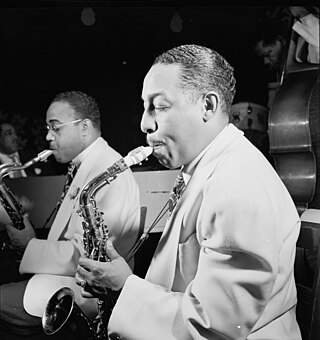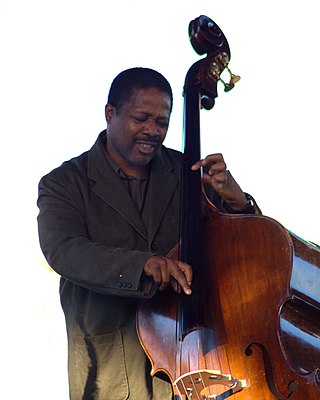Related Research Articles
Jazz is a music genre that originated in the African-American communities of New Orleans, Louisiana, in the late 19th and early 20th centuries, with its roots in blues and ragtime. Since the 1920s Jazz Age, it has been recognized as a major form of musical expression in traditional and popular music. Jazz is characterized by swing and blue notes, complex chords, call and response vocals, polyrhythms and improvisation. Jazz has roots in European harmony and African rhythmic rituals.

Cornelius "Johnny" Hodges was an American alto saxophonist, best known for solo work with Duke Ellington's big band. He played lead alto in the saxophone section for many years. Hodges was also featured on soprano saxophone, but refused to play soprano after 1946. Along with Benny Carter, Hodges is considered to be one of the definitive alto saxophone players of the big band era.

Jazz royalty is a term encompassing the many jazz musicians who have been termed as exceptionally musically gifted and informally granted honorific, "aristocratic" or "royal" titles as nicknames. The practice of affixing honorific titles to the names of jazz musicians goes back to New Orleans at the start of the 20th century, before the genre was commonly known as "jazz".

The Newport Jazz Festival is an annual American multi-day jazz music festival held every summer in Newport, Rhode Island. Elaine Lorillard established the festival in 1954, and she and husband Louis Lorillard financed it for many years. They hired George Wein to organize the first festival and bring jazz to Rhode Island.

Jazz at Lincoln Center is part of Lincoln Center in New York City. The organization was founded in 1987 and opened at Time Warner Center in October 2004. Wynton Marsalis is the artistic director and the leader of the Jazz at Lincoln Center Orchestra.

Geoffrey Champion Ward is an American editor, author, historian and writer of scripts for American history documentaries for public television. He is the author or co-author of 19 books, including 10 companion books to the documentaries he has written. He is the winner of seven Emmy Awards.
"In a Sentimental Mood" is a jazz composition by Duke Ellington. He composed the piece in 1935 and recorded it with his orchestra during the same year. Lyrics were written by Manny Kurtz; Ellington's manager Irving Mills gave himself a percentage of the publishing, so the song was credited to all three. Other popular versions in 1935/36 were by Benny Goodman and by Mills Blue Rhythm Band. The opening notes of the song's melody resemble Gershwin's "Someone To Watch Over Me".

"Tiger Rag" is a jazz standard that was recorded and copyrighted by the Original Dixieland Jass Band in 1917. It is one of the most recorded jazz compositions. In 2003, the 1918 recording of "Tiger Rag" was entered into the U.S. Library of Congress National Recording Registry.

George Mesrop Avakian was an American record producer, artist manager, writer, educator and executive. Best known for his work from 1939 to the early 1960s at Decca Records, Columbia Records, World Pacific Records, Warner Bros. Records, and RCA Records, he was a major force in the expansion and development of the U.S. recording industry. Avakian functioned as an independent producer and manager from the 1960s to the early 2000s and worked with artists such as Louis Armstrong, Miles Davis, Duke Ellington, Benny Goodman, Dave Brubeck, Eddie Condon, Keith Jarrett, Erroll Garner, Buck Clayton, Sonny Rollins, Paul Desmond, Edith Piaf, Bob Newhart, Johnny Mathis, John Cage, Alan Hovhaness, Ravi Shankar, and many other notable jazz musicians and composers.

Rodney Whitaker is an American jazz double bass player and educator.

Ken Burns Jazz: John Coltrane is a compilation album by jazz musician John Coltrane. It is part of a series of tie-in compilations from various labels to the PBS miniseries Ken Burns Jazz.

Taft Jordan was an American jazz trumpeter.
George Edward "Butch" Ballard was an American jazz drummer who played with Louis Armstrong, Count Basie, and Duke Ellington.
Michael Brooks was a British-born music historian, archivist, consultant, and producer.

Charles Davis was an American jazz saxophonist and composer. Davis played alto, tenor and baritone saxophone, and performed extensively with Archie Shepp and Sun Ra.

JAZZ: The Smithsonian Anthology is a six-CD, box-set released by Smithsonian Folkways that covers the history of jazz. The set includes 111 tracks with representative works from many styles, including big band, dixieland, free jazz, fusion, Latin jazz, swing, and smooth jazz. An accompanying 200-page book includes essays, analysis, and photographs.
Columbia Jazz Masterpieces was a series of Jazz CD, LP and cassette reissues from Columbia Records which began in 1986. Written inside the blue box used on all the album covers "Digitally Remastered Directly from the Original Analog Tapes." In Europe, the series was known as CBS Jazz Masterpieces, with the reissues being released by CBS Records, until 1991, when the Columbia Jazz Masterpieces title was used on all subsequent releases and represses.

Jazz ambassadors is the name often given to jazz musicians who were sponsored by the US State Department to tour Eastern Europe, the Middle East, central and southern Asia and Africa as part of cultural diplomacy initiatives to promote American values globally.
Sacred jazz is jazz composed and performed with religious intent.
References
- 1 2 "Episode Descriptions". Jazz: A Film by Ken Burns website. Arlington, Virginia: PBS . Retrieved 2013-10-30.
- 1 2 "Columbia Records/Legacy Recordings and The Verve Music Group To Jointly Release Recordings From 'JAZZ,' a Film by Ken Burns". PRNewswire . Cision. August 9, 2000. Archived from the original on August 15, 2000. Retrieved June 11, 2019– via Yahoo.com.
- ↑ "Outstanding Informational Series Nominees / Winners 2001".
- 1 2 Mark Gilbert, Amazon.co.uk review
- ↑ Charles Paul Freund, "Epic Jazz", Reason, January 8, 2001
- ↑ Jason Van Bergen, "Ken Burns: Jazz" Archived 2005-05-07 at the Wayback Machine , December 11, 2002
- ↑ Ratliff, Ben (2001-01-07). "Fixing, For Now, The Image Of Jazz". The New York Times. ISSN 0362-4331 . Retrieved 2020-01-01.
- ↑ "A Jazz Feast". National Review. 2001-01-06. Retrieved 2020-01-01.
- ↑ Santoro, Gene (2001-01-12). "All That Jazz". The Nation. ISSN 0027-8378 . Retrieved 2020-01-01.
- ↑ "Burns' Jazz Doesn't Swing". Observer. 2001-01-15. Retrieved 2020-01-01.
- ↑ "Jazz: The Obituary". The Guardian. 25 May 2001. Retrieved 10 May 2020.
- ↑ Tirro, Frank (2011). "Film Review: Ken Burns's Jazz". teachinghistory.org. Retrieved 10 May 2020.